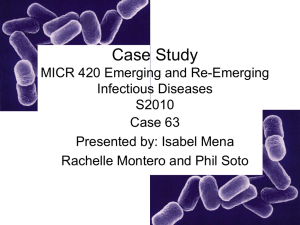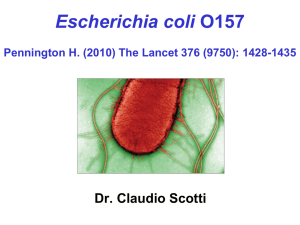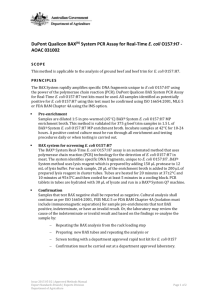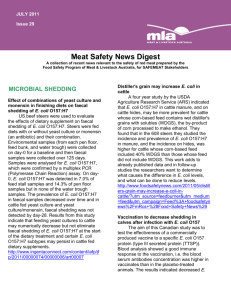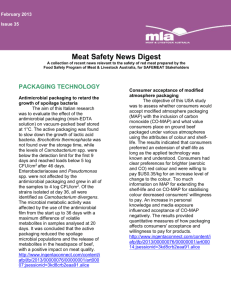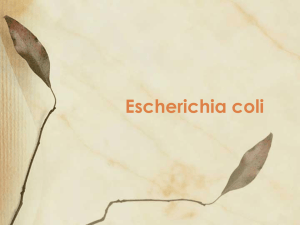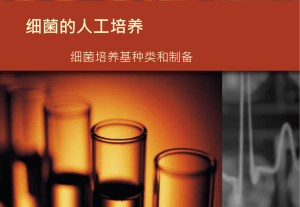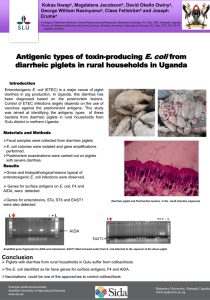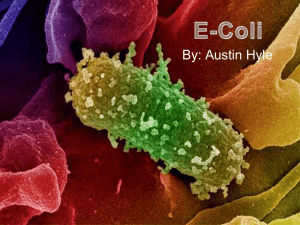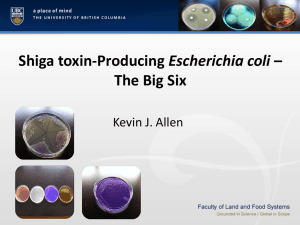2003 Poster by Marty Collins (WSLH) for ASM on E. Coli 0157 Work
advertisement
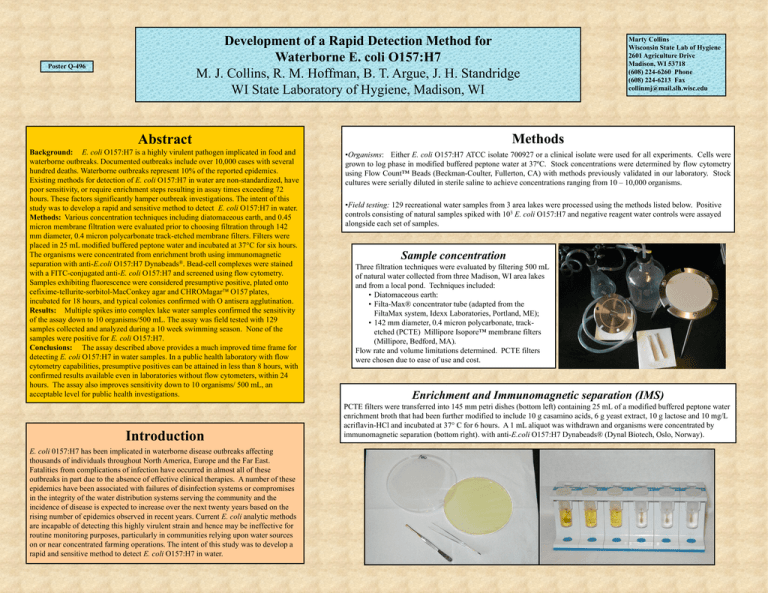
Development of a Rapid Detection Method for Waterborne E. coli O157:H7 M. J. Collins, R. M. Hoffman, B. T. Argue, J. H. Standridge WI State Laboratory of Hygiene, Madison, WI Poster Q-496 Marty Collins Wisconsin State Lab of Hygiene 2601 Agriculture Drive Madison, WI 53718 (608) 224-6260 Phone (608) 224-6213 Fax collinmj@mail.slh.wisc.edu Abstract Methods Background: E. coli O157:H7 is a highly virulent pathogen implicated in food and waterborne outbreaks. Documented outbreaks include over 10,000 cases with several hundred deaths. Waterborne outbreaks represent 10% of the reported epidemics. Existing methods for detection of E. coli O157:H7 in water are non-standardized, have poor sensitivity, or require enrichment steps resulting in assay times exceeding 72 hours. These factors significantly hamper outbreak investigations. The intent of this study was to develop a rapid and sensitive method to detect E. coli O157:H7 in water. Methods: Various concentration techniques including diatomaceous earth, and 0.45 micron membrane filtration were evaluated prior to choosing filtration through 142 mm diameter, 0.4 micron polycarbonate track-etched membrane filters. Filters were placed in 25 mL modified buffered peptone water and incubated at 37C for six hours. The organisms were concentrated from enrichment broth using immunomagnetic separation with anti-E.coli O157:H7 Dynabeads®. Bead-cell complexes were stained with a FITC-conjugated anti-E. coli O157:H7 and screened using flow cytometry. Samples exhibiting fluorescence were considered presumptive positive, plated onto cefixime-tellurite-sorbitol-MacConkey agar and CHROMagar O157 plates, incubated for 18 hours, and typical colonies confirmed with O antisera agglutination. Results: Multiple spikes into complex lake water samples confirmed the sensitivity of the assay down to 10 organisms/500 mL. The assay was field tested with 129 samples collected and analyzed during a 10 week swimming season. None of the samples were positive for E. coli O157:H7. Conclusions: The assay described above provides a much improved time frame for detecting E. coli O157:H7 in water samples. In a public health laboratory with flow cytometry capabilities, presumptive positives can be attained in less than 8 hours, with confirmed results available even in laboratories without flow cytometers, within 24 hours. The assay also improves sensitivity down to 10 organisms/ 500 mL, an acceptable level for public health investigations. •Organisms: Either E. coli O157:H7 ATCC isolate 700927 or a clinical isolate were used for all experiments. Cells were grown to log phase in modified buffered peptone water at 37ºC. Stock concentrations were determined by flow cytometry using Flow Count™ Beads (Beckman-Coulter, Fullerton, CA) with methods previously validated in our laboratory. Stock cultures were serially diluted in sterile saline to achieve concentrations ranging from 10 – 10,000 organisms. Introduction E. coli 0157:H7 has been implicated in waterborne disease outbreaks affecting thousands of individuals throughout North America, Europe and the Far East. Fatalities from complications of infection have occurred in almost all of these outbreaks in part due to the absence of effective clinical therapies. A number of these epidemics have been associated with failures of disinfection systems or compromises in the integrity of the water distribution systems serving the community and the incidence of disease is expected to increase over the next twenty years based on the rising number of epidemics observed in recent years. Current E. coli analytic methods are incapable of detecting this highly virulent strain and hence may be ineffective for routine monitoring purposes, particularly in communities relying upon water sources on or near concentrated farming operations. The intent of this study was to develop a rapid and sensitive method to detect E. coli O157:H7 in water. •Field testing: 129 recreational water samples from 3 area lakes were processed using the methods listed below. Positive controls consisting of natural samples spiked with 103 E. coli O157:H7 and negative reagent water controls were assayed alongside each set of samples. Sample concentration Three filtration techniques were evaluated by filtering 500 mL of natural water collected from three Madison, WI area lakes and from a local pond. Techniques included: • Diatomaceous earth: • Filta-Max® concentrator tube (adapted from the FiltaMax system, Idexx Laboratories, Portland, ME); • 142 mm diameter, 0.4 micron polycarbonate, tracketched (PCTE) Millipore Isopore™ membrane filters (Millipore, Bedford, MA). Flow rate and volume limitations determined. PCTE filters were chosen due to ease of use and cost. Enrichment and Immunomagnetic separation (IMS) PCTE filters were transferred into 145 mm petri dishes (bottom left) containing 25 mL of a modified buffered peptone water enrichment broth that had been further modified to include 10 g casamino acids, 6 g yeast extract, 10 g lactose and 10 mg/L acriflavin-HCl and incubated at 37° C for 6 hours. A 1 mL aliquot was withdrawn and organisms were concentrated by immunomagnetic separation (bottom right). with anti-E.coli O157:H7 Dynabeads® (Dynal Biotech, Oslo, Norway). Flow cytometric detection and confirmation Bead-cell complexes were stained with a FITC-conjugated anti-E. coli O157:H7 antibody (KPL, Gaithersburg, MD) and screened with a Beckman-Coulter EPICS XL flow cytometer (top left). Formation of a fluorescent magnetic bead-organism complex (top right, positive) indicates the presence of E. coli O157:H7, while the failure to form such a complex (top right, negative) indicates the sample does not contain E. coli O157:H7. Samples exhibiting fluorescence (bottom left) were considered presumptive positive and plated (bottom right) onto cefixime-tellurite-sorbitol-MacConkey agar and CHROMagar™ O157 plates (CHROMagar, Paris, France) or Rainbow O157 agar (Biolog, Hayward, CA). Plates were incubated for 18 hours at 37° C and typical colonies confirmed by O antisera agglutination. Flow cytometric histograms depicting peak FITC-fluorescence (X-axis) vs. log forward angle light scatter (Yaxis). The presence of fluorescent events indicates the presence of E. coli O157:H7. Panels A-C show results from distilled water seeded with 0, 10, and 100 E.coli O157:H7 in 500 ml. Panels B-D show results from lake water seeded with 0, 10, and 100 E.coli O157:H7 in 500 ml. Negative control 10 organisms/500 ml 100 organisms/500 ml B C E F A Distilled water D Lake water Rainbow O157 Agar-Black colonies are E. coli O157 Conclusions CT-SMAC-E.coli O157 CHROMagar O157-E.coli O157 We have developed an E. coli 0157:H7 method utilizing IMS with flow cytometric detection following concentration and a 6 hour enrichment. This method is capable of detecting 10 organisms in 500 mL natural water samples – a significant sensitivity improvement over currently accepted methods which may take up to 72 hours for confirmation. In a public health laboratory with flow cytometry capabilities, presumptive positives can be attained in less than 8 hours, with confirmed results available even in laboratories without flow cytometers, within 24 hours. Results 1. Both the FiltaMax concentrator tube filtration system and the PCTE membrane were capable of filtering 500 mL natural water samples. Diatomaceous earth filters were not capable of filtering the entire sample volume. PCTE membranes were chosen due to ease of use and cost. 2. Both reagent water and natural water samples spiked with 10, 100, and 1000 organisms were positive using the IMS/flow cytometric method described above. 3. The assay was field tested with 129 samples collected and analyzed during a 10 week swimming season. None of the samples were positive for E. coli O157:H7. Positive and negative control samples were acceptable for all samples analyzed. Future Research • • • • Delayed exposure of various antibiotics and use of media additives (e.g., antioxidants) to improve culturability of viable but non-culturable organisms PCR confirmation Determining optimal enrichment temperatures for culturing viable but non-culturable organisms Further comparison of CT-SMAC, CHROMagar O157, & Rainbow Agar O157 Acknowledgements This project is being conducted by the Wisconsin State Laboratory of Hygiene, Madison Department of Public Health, and the United States Geological Survey. This project is being funded by the U.S. EPA, Project # R82933901-0.
